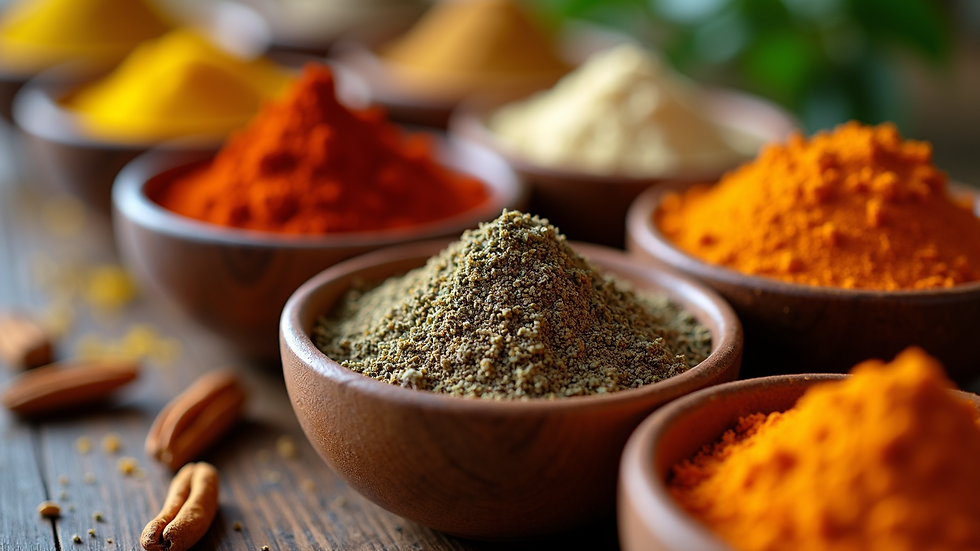The Basics of Using Seasoning Rubs for Meat
- Reweti Montgomery
- Jul 21
- 3 min read
Cooking with seasoning rubs adds flavor and depth to your meat dishes. Whether you're grilling, smoking, or roasting, a good rub can transform simple cuts into culinary masterpieces. This blog post will dive into the basics of using seasoning rubs for meat, covering everything from the types of rubs to their application.
What Are Seasoning Rubs?
Seasoning rubs are combinations of spices and herbs used to flavor meat before cooking. They can be dry mixes or pastes, and they enhance the meat's natural flavors while adding complexity. A well-crafted rub complements the type of meat you're using, ensuring the flavor penetrates the surface.
One of the best things about seasoning rubs is that they can cater to various culinary styles, from smoky barbecue flavors to savory herb blends. Experimentation is key to discovering what works best for your palate and recipes.

Types of Seasoning Rubs
There are primarily two types of seasoning rubs: dry rubs and wet rubs. Understanding the differences can help you choose the right type for your dish.
Dry Rubs
Dry rubs consist of a mixture of spices, salt, and herbs. They are typically applied to meat in a generous coating, allowing the flavors to meld together as the meat cooks. Some popular dry rub ingredients include:
Paprika: Adds a sweet and smoky flavor.
Black Pepper: Provides heat and sharpness.
Cumin: Offers an earthy taste.
Brown Sugar: Caramelizes during cooking, adding sweetness.
Dry rubs are ideal for barbecue meats, as they create a flavorful crust that seals in moisture.

Wet Rubs
On the other hand, wet rubs contain wet ingredients mixed with spices, such as oils, mustards, or fruit juices. This type of rub adds moisture to the meat while imparting flavor. Common ingredients for wet rubs are:
Olive Oil: Helps in flavor absorption and prevents drying.
Soy Sauce: Adds saltiness and umami flavor.
Honey: Contributes sweetness and helps sugars caramelize.
Wet rubs are perfect for meats that may need extra moisture during cooking, like chicken or pork.
How to Apply Seasoning Rubs
Applying seasoning rubs correctly ensures the best flavor infusion. Here are some steps to follow:
Choose the Right Rub: Select a rub that complements the meat type.
Prep the Meat: Pat the meat dry with paper towels to remove excess moisture. This helps the rub stick better.
Apply Generously: Use your hands to rub the seasoning into the meat, covering all surfaces. Rubs can be applied just before cooking or left on for several hours or overnight for a stronger flavor.
Rest the Meat: After applying the rub, let the meat sit for at least 30 minutes. This allows the flavors to penetrate.
Timing Matters
The length of time you leave the rub on before cooking can affect the flavor significantly. For potent flavors, leave wet rubs on for a minimum of 1 hour or even overnight. Conversely, dry rubs generally benefit from resting for at least 30 minutes, but keeping them on longer can enhance the taste.

Tips for Perfecting Your Rub
While the basics of applying rubs are straightforward, fine-tuning your technique can enhance your results:
Experiment with Ingredients: Try different spice combinations. Don’t be afraid to adjust measurements to suit your taste.
Consistency is Key: Aim for a consistent texture for your dry rub. If your spices are too coarse, they might not adhere properly.
Think About Cooking Methods: Different cooking methods may require different rubs. For example, grilling benefits from a good dry rub, while baking can use wet rubs for juiciness.
Store Properly: If you have leftovers, store them in an airtight container away from direct sunlight. Most dry rubs can last for months, while wet rubs should be used within a week.
Conclusion: Elevate Your Cooking with Seasoning Rubs
Integrating seasoning rubs into your cooking routine can truly elevate your meat dishes. Whether you're trying out traditional recipes or exploring new flavors, the right rub can make all the difference. Don’t forget to check resources, such as meat rubs nz, for additional inspiration and options.
Understanding the basics of using seasoning rubs enables you to embrace more flavor in your meals, paving the way for culinary creativity and delicious results.
Feel free to experiment and enjoy the process. Your taste buds will thank you!



Comments